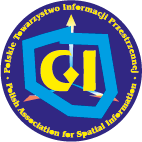Porównanie wybranych metod analizy dostępności przestrzennej na przykładzie obiektów użyteczności publicznej w Toruniu
Streszczenie
Niniejszy artykuł ma na celu ocenę wybranych metod analizy dostępności przestrzennej i ich wpływu na uzyskiwane wyniki czasów dojazdu. Porównaniu poddano metodę izochron (stref obsługi) oraz metodę pól odniesienia. Obie metody zastosowano do oceny dostępności wybranych obiektów użyteczności publicznej w Toruniu.
Przesłano 22.08.2017 Zaakceptowano 3.07.2018 Opublikowano 16.08.2018
Pełny tekst:
PDFBibliografia
AccessAdvisr, 2017: https://accessadvisr.net/
Balfour Reuben, Allen Jessica, 2014: Local action on health inequalities: Improving access to green spaces. Public Health England, UCL Institute of Health Equity.
Bielecka Elżbieta, Filipczak Anna, 2010: Zasady opracowywania map dostępności (Principals of elaborating accessibility maps). Roczniki Geomatyki 8 (6): 29-39, Warszawa: PTIP.
Chiesura Anna, 2004: The Role of Urban Parks for the Sustainable City. Landscape and Urban Planning 68 (1): 129-38. https://doi.org/10.1016/j.landurbplan.2003.08.003
Comber, Alexis, Brunsdon Chris, Green Edmund, 2008: Using a GIS-based network analysis to determine urban greenspace accessibility for different ethnic and religious groups. Landscape and Urban Planning 86 (1): 103-114.
Delamater Paul L., 2013: Spatial Accessibility in Suboptimally Configured Health Care Systems: A Modified Two-Step Floating Catchment Area (M2SFCA) Metric. Health & Place 24 (listopad): 30-43. https://doi.org/10.1016/j.healthplace.2013.07.012
Dominiak Joanna, 2015: Dostępność usług publicznych na terenie województwa wielkopolskiego (Accessibility to public services in the wsielkopolska Voivodship). http://www.umww.pl/attachments/article/11578/1.Dost%C4%99pno%C5%9B%C4%87%20us%C5%82ug%20publicznych%20na%20terenie%20wojew%C3%B3dztwa%20wielkopolskiego.pdf
Florczak Maciej, 2013: GIS jako narzędzie badania dostępności przestrzennej transportu zbiorowego (GIS as an tool in analysis of spatial accessibility of the public transport system). Transport Miejski i Regionalny 5: 22-27.
Galton Francis, 1881: On the construction of isochronic passage charts. Proceedings of the Royal Geographical Society 3: 657-658.
General Transit Feed Specification - Wikipedia, 2017: 24.06.2017. https://en.wikipedia.org/wiki/General_Transit_Feed_Specification
Google Maps Distance Matrix API, b.d.: Google Developers. 2.08.2017. https://developers.google.com/maps/documentation/distance-matrix/
Guzik Robert, 2003a: Interpretacja przestrzennej dostępności szkół ponadpodstawowych w oparciu o metodę ilorazu potencjałów ((Interpretation of spatial accessibility of secondary schools basing on the potential quotient method). [W:] Problemy interpretacji wyników metod badawczych stosowanych w geografii społeczno-ekonomicznej i gospodarce przestrzennej: 101–110. Poznań, Wydawnictwo Naukowe Bogucki.
Guzik Robert, 2003b: Przestrzenna dostępność szkolnictwa ponadpodstawowego (Spatial accessibility of secondary schools). Kraków, Instytut Geografii i Gospodarki Przestrzennej Uniwersytetu Jagiellońskiego.
Komornicki Tomasz, Śleszyński Przemysław, Pomianowski Wojciech, Rosik Piotr, Siłka Piotr, Stępniak Marcin, 2008: Opracowanie metodologii liczenia wskaźnika międzygałęziowej dostępności transportowej terytorium Polski oraz jego oszacowanie (Devising a methodology for calculating the indicator of intermodal transport accessibility for the territory of Poland, as well as making its assessment). Warszawa, IGiPZ PAN, Google Scholar. http://www.pois.gov.pl/AnalizyRaportyPodsumowania/Documents/2009.01.22_wskaznik_dostepnosci__POIiS_opis.pdf
Langford Mitchel, Higgs Gary, Fry Richard, 2016: Multi-Modal Two-Step Floating Catchment Area Analysis of Primary Health Care Accessibility. Health & Place 38 (march): 70-81. https://doi.org/10.1016/j.healthplace.2015.11.007
Lee Gyoungju, Hong Ilyoung, 2013: Measuring Spatial Accessibility in the Context of Spatial Disparity between Demand and Supply of Urban Park Service. Landscape and Urban Planning 119 (november): 85-90. https://doi.org/10.1016/j.landurbplan.2013.07.001
Lijewski Teofil, 1985: Układy komunikacyjne województw (Communication systems in voivodships). Dokumentacja Geograficzna, Warszawa, IGiPZ PAN.
Lovett Andrew, Haynes Robin, Sünnenberg Gisela, Gale S., 2002: Car travel time and accessibility by bus to general practitioner services: a study using patient registers and GIS. Social Science & Medicine 55 (1): 97-111.
Luo Wei, Qi Yi, 2009: An Enhanced Two-Step Floating Catchment Area (E2SFCA) Method for Measuring Spatial Accessibility to Primary Care Physicians. Health & Place 15 (4): 1100-1107. https://doi.org/10.1016/j.healthplace.2009.06.002
Luo Wei, Wang Fahui, 2003: Measures of Spatial Accessibility to Health Care in a GIS Environment: Synthesis and a Case Study in the Chicago Region. Environment and Planning B: Planning and Design 30 (6): 865-84. https://doi.org/10.1068/b29120
Mapumental | mySociety, 2015: https://mapumental.com/
McGrail Matthew R., Humphreys John S., 2014: Measuring Spatial Accessibility to Primary Health Care Services: Utilising Dynamic Catchment Sizes. Applied Geography 54 (october): 182-88. https://doi.org/10.1016/j.apgeog.2014.08.005
Michniewicz-Ankiersztajn Hanna, 2014: Rola zieleni w kształtowaniu przestrzeni miast europejskich w kontekście jakości życia ich mieszkańców (The role of green areas in European cities’ spaces in the context of the quality of life of inhabitants). https://doi.org/10.5281/zenodo.13264
Nelson Andrew, 2008: Estimated travel time to the nearest city of 50,000 or more people in year 2000. Global Environment Monitoring Unit - Joint Research Centre of the European Commission, Ispra Italy. http://forobs.jrc.ec.europa.eu/products/gam/
Nowe dane demograficzne w siatkach kilometrowych dostępne w formacie shp - Start - Portal Geostatystyczny (New demographic data in 1-kilometre grids in the shp format - Start - Geostatistical Portal), b.d.: 2.08.2017. https://geo.stat.gov.pl/start/-/asset_publisher/jNfJiIujcyRp/content/id/45261
OD cost matrix analysis—Help | ArcGIS Desktop, b.d.: 2.08.2017. http://desktop.arcgis.com/en/arcmap/latest/extensions/network-analyst/od-cost-matrix.htm
Oh Kyushik, Jeong Seunghyun, 2007: Assessing the spatial distribution of urban parks using GIS. Landscape and urban planning 82 (1-2): 25-32.
OSRM API Documentation, b.d.: 2.082017. http://project-osrm.org/docs/v5.9.1/api/#table-service
Peng Zhong-Ren, 1997: The Jobs-Housing Balance and Urban Commuting. Urban Studies 34 (8): 1215-1235. https://doi.org/10.1080/0042098975600
Pietrusiewicz Witold, 1996: Problemy metodyczne opracowywania map dostępności czasowej (Methodological issues related to development of time accessibility maps). Polski Przegląd Kartograficzny 28 (2): 87-99.
Stępniak Marcin, 2013: Wykorzystanie metody 2SFCA w badaniach dostępności przestrzennej usług medycznych (The application of the two-step floating catchment area metod to the studies of accessibility of healthcare services). Przegląd Geograficzny 85 (2): 199-218. https://doi.org/10.7163/PrzG.2013.2.3
Tyrväinen Liisa, Mäkinen Kirsi, Schipperijn Jasper, 2007: Tools for Mapping Social Values of Urban Woodlands and Other Green Areas. Landscape and Urban Planning 79 (1): 5-19. https://doi.org/10.1016/j.landurbplan.2006.03.003
Wielebski Łukasz, 2013: Wizualizacja kartograficzna dostępności czasowej dla służb ratowniczych (Cartographic visualisation of time accessibility for rescue services). [W:] Pragmatyka w kartografii, Prace i studia kartograficzne 4: 151-62.
Zhu Xuan, Liu Suxia, 2004: Analysis of the impact of the MRT system on accessibility in Singapore using an integrated GIS tool. Journal of Transport Geography 12 (2): 89-101.
Zhu Xuan, Liu Suxia, Yeow Mun-Ching, 2006a: A GIS-based multi-criteria analysis approach to accessibility analysis for housing development in Singapore. Retrieved Oct.
Zhu Xuan, Liu Suxia, Yeow Mun-Ching, 2006b: Accessibility analysis for housing development in Singapore with GIS and multi-criteria analysis methods. Applied GIS 2 (2): 13.1-13.12.
